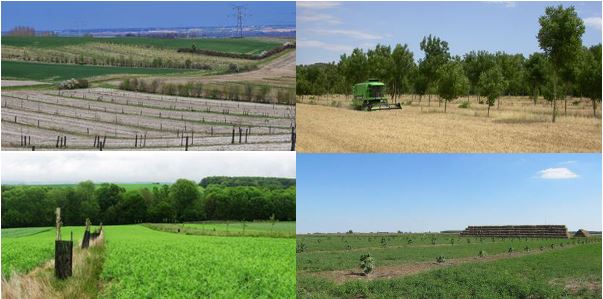Describing Agroforestry Systems for Arable Farmers: A Summary

Thirteen stakeholder groups across Europe have produced system descriptions of the components, structure, ecosystem services, and economic value of selected agroforestry systems for arable farmers. Each system involves alley cropping to allow the use of standard machinery and the alley widths range from 6 m to 96 m. Dr Jaconette Mirck, the leader of work-package 4, was produced a short synthesis of the thirteen reports. The individual system description reports are also available on the appropriate website.
Mirck, J. (2016). Agroforestry for Arable Systems: Synthesis of System Descriptions. Deliverable 4.10 (4.1) for EU FP7 Research Project: AGFORWARD 613520. 15 pp
In Southern France, the systems include durum wheat production beneath walnut, poplar and Sorbus with a focus on the selection of durum wheat varieties (Gosme and Meziere, 2016) or weed control (Meziere and Gosme, 2016). In Picardy in Northern France, the alley width ranges from 26 m to 50 m with a wide range of tree species (Wartelle et al., 2016). In Western France, the focus is on a black walnut intercropping system (Van Leberghe et al. 2016).
In Spain, there is an interest in cereal production beneath walnut (Moreno et al. 2016) and the cultivation of maize or medicinal plants between walnut and wild cherry (Mosquera Losada et al. 2016). Other Southern European systems include field beans and aromatic plants between walnut and cherry in Greece (Mantzanas et al., 2016) and poplar and oak being grown in arable fields in Italy (Paris et al. 2016).
In central Europe the systems include growing paulownia with alfalfa and maize in Hungary (Vityi et al., 2016), growing sugar beet with poplar and black locust short rotation coppice in Germany (Mirck et al. 2016), and a wide range of systems in Switzerland (Petrillo and Herzog, 2016). In the UK, the systems involve a mix of broadleaf trees with organic vegetable production (Smith and Venot, 2016) and wheat variety selection between hazel and willow coppice (Smith, 2016).
- Gosme M and Meziere D (2016). System Report: Durum Wheat Production in Agroforestry Systems in France. 18 January 2016. 12 pp. Available online: mediterranean-silvoarable-systems-in-france.html
- Mantzanas K, Papanastasis V, Pantera A, Papadopoulos A (2016). Systems Description: Silvoarable Agroforestry in Greece. 10 February 2016. 7 pp. Available online: trees-with-arable-crops-and-grassland-in-greece.html
- Meziere D and Gosme M (2016). System Report: Weed survey in Mediterranean Silvoarable Group in France. 15 January 2016. 9 pp. Available online: mediterranean-silvoarable-systems-in-france.html
- Mirck J, Kanzler M, Quinckenstein A (2016). System Report: Alley Cropping in Germany. 30 October 2015. 11 pp. Available online: alley-cropping-systems-in-germany.html
- Moreno G, Arenas G, Lopez-Diaz ML, Bertomeu M, Caceres Y, and Juarez E (2016). System Report: Cereal Production beneath Walnut in Spain. 1 October 2015. 12 pp. Available online: http://www.agforward.eu/silvoarable-systems-in-spain.html
- Mosquera Losada MR, Ferreiro-Domínguez N, Fernández Lorenzo JL, González-Hernández P, Rigueiro Rodríguez A (2016). System Report: Silvoarable Systems in Galicia, Spain. 13 January 2016. 11 pp. Available online: http://www.agforward.eu/silvoarable-systems-in-spain.html
- Paris P, Laureti M, Ciolfi M and dalla Valle C (2016). System Report: Trees for timber with Arable Crops in Italy. 18 January 2016. 17 pp. Available online: trees-for-timber-intercropped-with-cereals-445.html
- Petrillo M and Herzog F (2016). System Report: Silvoarable Agroforestry in Switzerland. 12 February 2016. 12 pp. Available online: integrating-trees-with-arable-crops-switzerland.html
- Smith J (2016). System Report: Silvoarable Agroforestry in the UK I. 12 January 2016. 17 pp. Available online: silvoarable-agroforestry-in-the-uk.html
- Smith J and Venot C (2016). System Report: Silvoarable Agroforestry in the UK II. 27 October 2015. 13 pp. Available online: silvoarable-agroforestry-in-the-uk.html
- Van Lerberghe P, Malignier N, Hannachi Y (2016). System description: Walnut Trees on Arable Land in France. 18 January 2016. 10 pp. Available online: agroforestry-for-arable-farmers-in-western-france.html
- Vityi A, Marosvoeglyi B, Kiss A, Schettrer P (2016). System report: Alley Cropping in Hungary. 30 November 2015. 11 pp. Available online: alley-cropping-systems-in-hungary.html
- Wartelle R, Meziere D, Gosme M and La-Laurent L (2016). System report: Weed Survey in Northern Silvoarable Group in France. 15 January 2016. 8 pp. Available online: http://www.agforward.eu/mediterranean-silvoarable-systems-in-france.html